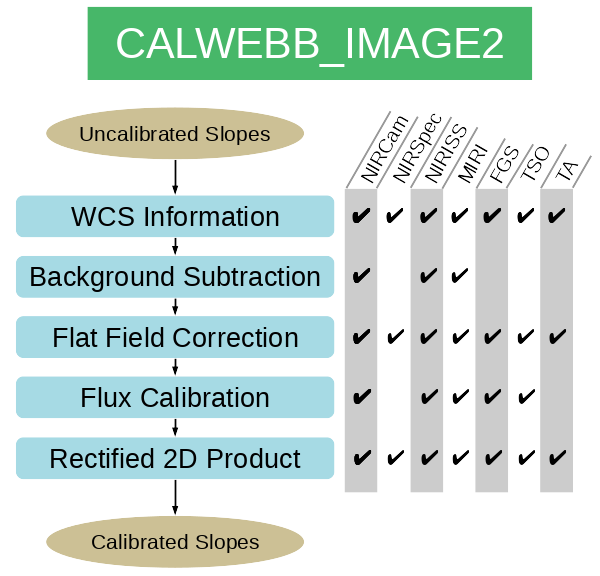calwebb_image2
The calwebb_image2 module is stage 2 of the JWST Science Calibration Pipeline for all imaging observations. The input to this stage is the individual uncalibrated slope images (calwebb_detector1 output) and the output is individual calibrated slope images. The steps are listed in Figure 1 with the flow from the top to the bottom. Note that all steps in this module are common to both NIR and MIR data, although not all steps are applicable to all observation modes.
On this page
Words in bold are GUI menus/
panels or data software packages;
bold italics are buttons in GUI
tools or package parameters.
A brief description of each of the steps within calwebb_image2 can be found below, along with links to further details (e.g., the relevant reference files) that can be found on the corresponding ReadTheDocs pages. Note, however, that the reference files themselves are all provided via CRDS. For instrument mode-specific notes on these pipeline steps see the corresponding known issues with JWST data articles.
Click on the image for a larger view.
WCS information
ReadTheDocs documentation: Assign WCS
Package name: assign_wcs
The information to transfer pixel coordinates to astronomical coordinates (e.g., RA and Dec) is added to the data with this step. This combines instrument distortion model information from calibration reference files with attitude information about where in the sky JWST was pointing to create a full chain of transforms from detector pixels to on-sky coordinates. This attitude information is drawn from a set of 5 header keywords describing the sky position (RA_REF, DEC_REF) at a given location in the JWST telescope frame (V2_REF, V3_REF) and the relative angle between those spherical coordinate systems (ROLL_REF). Additional corrections are made for effects such as velocity aberration.
The final transformation chain is encoded in the ASDF format and attached as an extension to the data that can be queried using the JWST data models. The WCS information and distortion model are provided by instrument and detector specific calibration reference files. The image data itself is not modified by this step.
Background subtraction
ReadTheDocs documentation: Background Image Subtraction
Package name: See the link above for details
If an APT-specified background target was observed, a combined background image constructed from all exposures of that target is subtracted from the science target exposure. The background observations can be specified by the user when the calibration pipeline is rerun manually.
Flat field correction
ReadTheDocs documentation: Flat Field Correction
Package name: flat_field
The flat field corrects for pixel-to-pixel variations and large scale variations in the instrument+telescope responsivity. The flat field image is taken from instrument- and detector-specific calibration reference files.
Flux calibration
ReadTheDocs documentation: Photometric Calibration
Package name: photom
The multiplicative conversion factor between counts/s and MJy/sr is applied to the data and recorded in the file header. A second conversion factor between counts/s and micro-Jy/sq arcsec is also recorded in the header, with both of these conversion factors being FITS keywords. The pixel area reference file is also attached to the data allowing conversion between surface brightness and flux density for each pixel.
Rectified 2-D product
ReadTheDocs documentation: Resampling
Package name: resample
As a product for the Archive, rectified 2-D images are created from individual exposures by removing the distortion and resampling the images onto a grid where all the pixels have the same spatial scale. This rectified 2-D product is not used in the calibration pipeline itself, it is useful for visual browsing of the data.
